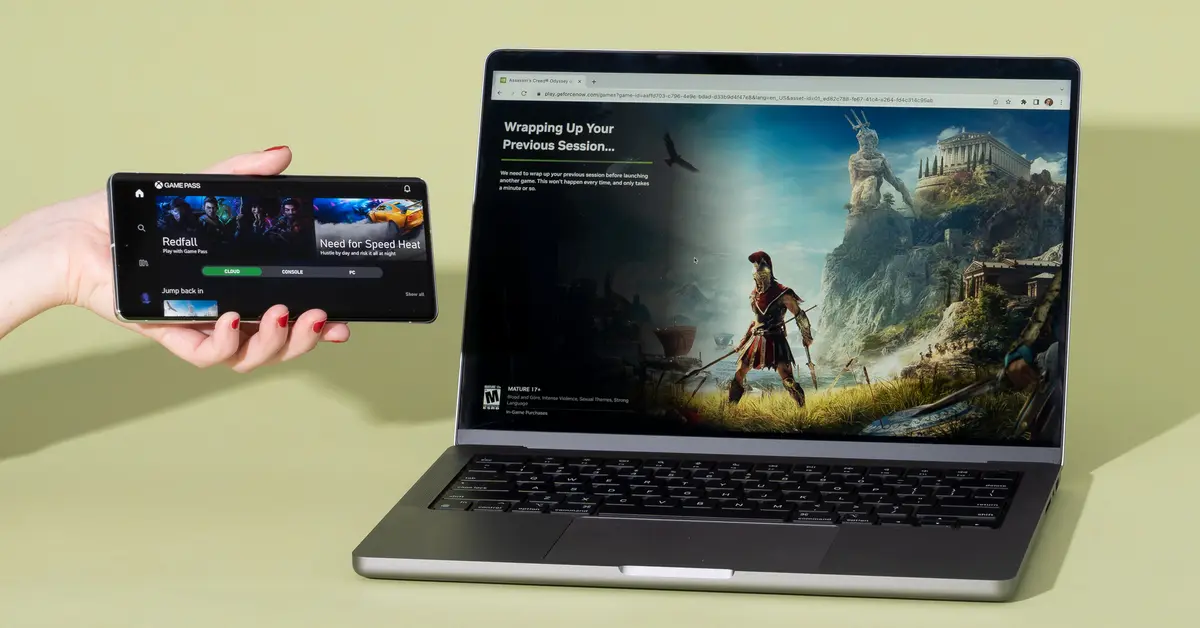Gaming has always been an arena where innovation meets entertainment, and over the past few decades, the landscape has shifted dramatically. From the pixelated joys of retro consoles to the hyper-realistic worlds of modern-day PCs, gamers have constantly sought better graphics, faster performance, and more immersive experiences. But now, a new challenger has emerged, reshaping the way we think about playing games: cloud gaming. The debate between cloud gaming and traditional gaming is heating up, and gamers around the world are asking the same question: which one will ultimately win? Will cloud gaming revolutionize the industry, or will traditional gaming hold its ground? In this article, we’ll dive deep into both worlds, explore the pain points, and highlight what makes each unique, all while keeping the discussion engaging and informative.
The Rise of Cloud Gaming
Cloud gaming, sometimes called gaming-as-a-service, is arguably the most disruptive shift in the industry since the introduction of home consoles. The concept is deceptively simple: instead of running a game on your own hardware, the game runs on a powerful remote server in a data center, and streams the visuals to your device in real-time. The appeal is enormous. Imagine playing the latest AAA titles on your laptop, smartphone, or even a low-end tablet without worrying about graphics cards, storage, or RAM. No downloads, no patches, no waiting for hours to update your game. Services like NVIDIA GeForce Now, Xbox Cloud Gaming, and Google Stadia have promised just that—instant access to high-quality gaming, anywhere and anytime. But as with any new technology, it comes with its own set of challenges.
The biggest pain point for cloud gaming is latency, also known as lag. When you press a button, the command must travel to the server, be processed, and then return to your device. Even a tiny delay can ruin fast-paced games like first-person shooters or competitive racing games. Then there’s the issue of internet stability. Unlike traditional gaming, which largely depends on your console or PC’s specs, cloud gaming demands a consistently fast and reliable internet connection. For many gamers in regions with patchy connectivity, this can be a dealbreaker. Yet, despite these hurdles, cloud gaming offers unmatched convenience. Picture a world where you can jump from playing an intense multiplayer shooter on your console to a casual slot game on your phone without skipping a beat. This kind of flexibility is reshaping how people perceive gaming itself.
The Strength of Traditional Gaming
Traditional gaming—playing games on dedicated hardware like consoles, PCs, or handheld devices—has been the bedrock of the industry for decades. Its strength lies in control, performance, and immersion. Gamers who invest in high-end PCs or consoles enjoy fluid graphics, high frame rates, and virtually zero latency. For competitive players, this is non-negotiable. Traditional gaming also provides offline access, meaning you’re not at the mercy of internet speed or server uptime.
But traditional gaming is not without its pain points. High-end gaming PCs can cost thousands of dollars, and even consoles are a significant investment when you factor in the price of games, accessories, and subscriptions. Game downloads and updates can be massive, often requiring hours or even days of waiting. There’s also the hassle of hardware upgrades—graphics cards, processors, and storage fill quickly and become outdated in a few years. However, despite these challenges, the tactile satisfaction of traditional gaming remains unparalleled. The feel of a controller in your hands, the quick response of a high-refresh-rate monitor, and the ability to mod or customize your setup keeps die-hard gamers firmly rooted in the traditional realm. Even when trying out mobile versions of games like a qq poker game on a phone or tablet, many players still gravitate toward PCs or consoles for the immersive depth and precision they offer.
Accessibility vs. Performance
One of the key battlegrounds between cloud and traditional gaming is accessibility versus performance. Cloud gaming’s main selling point is accessibility. A gamer with an entry-level laptop or even a smartphone can access titles that would otherwise require a top-tier gaming PC. There are no steep learning curves for hardware upgrades, and you can enjoy high-quality visuals and smooth gameplay without the financial burden of purchasing premium equipment. Moreover, cloud platforms often offer subscription-based models, which can be more cost-effective for casual gamers who want to explore a wide library without owning dozens of physical or digital copies.
Traditional gaming, in contrast, prioritizes performance. If you’re a gamer who demands 4K resolution, high frame rates, ray-tracing visuals, and ultra-realistic physics, cloud gaming may still fall short. While technology is advancing rapidly, streaming 4K at 60fps consistently requires a lightning-fast internet connection, which is not universally available. Additionally, cloud gaming platforms are at the mercy of server-side issues—downtime, maintenance, or regional restrictions can disrupt your gaming experience. On the other hand, traditional gaming gives you complete autonomy over your system. You control upgrades, mods, and tweaks, and your gaming experience is not dictated by an external server. The trade-off between accessibility and performance is perhaps the clearest line dividing these two approaches.
The Game Library: Quantity vs. Ownership
Another factor that sways gamers’ decisions is the game library. Cloud gaming platforms often boast vast libraries, giving you access to hundreds or even thousands of titles instantly. For example, you could switch from playing a narrative-driven adventure game to spinning the reels on a lotus303 game in seconds. This breadth is unmatched, particularly for gamers who enjoy variety and experimentation. Subscription models make it easy to explore titles without a significant financial commitment, which is appealing for casual players or those who like hopping between genres.
In traditional gaming, ownership is more concrete. You buy a game, and it’s yours—download it, play it offline, or keep it indefinitely without worrying about subscription cancellations. For many, this sense of ownership is crucial. Game preservation, modding communities, and the resale market thrive in the traditional ecosystem. Additionally, some genres, particularly competitive multiplayer or niche games like a poker game, rely heavily on precision and latency, which are better maintained on traditional platforms. Ultimately, the choice between quantity and ownership comes down to what kind of gamer you are: a curious explorer or a dedicated collector.
Social Interaction and Multiplayer
Multiplayer gaming is a cornerstone of modern gaming culture, and both cloud and traditional gaming have unique approaches to social interaction. Cloud gaming can simplify connecting with friends, especially if everyone doesn’t own the same console or PC. Cross-platform play is often easier because the game runs on the server rather than the device. This allows for more inclusive gaming sessions and can introduce casual gamers to titles they might not otherwise experience.
Traditional gaming, however, still reigns supreme when it comes to competitive multiplayer experiences. Lower latency, better control precision, and more customizable setups give players a tangible advantage in fast-paced environments. Professional eSports tournaments and competitive communities largely operate within the traditional gaming framework because cloud solutions simply cannot yet provide the same level of reliability and responsiveness. Yet, cloud gaming continues to push the envelope, aiming to bridge the social gap while maintaining performance. The potential to instantly jump into a shared game world with friends without any hardware constraints is undeniably enticing.
Cost Considerations
When it comes to cost, cloud and traditional gaming have stark differences. Cloud gaming reduces upfront costs dramatically. Instead of buying a powerful PC or next-gen console, you pay a subscription fee and use existing devices like laptops, tablets, or even smart TVs. This model is ideal for casual gamers, students, or anyone who wants to play without investing thousands upfront. However, there’s a hidden cost: reliance on a high-speed internet connection and potential data usage charges. Over time, subscription fees can also add up, and if the service shuts down or discontinues games, access to your library disappears.
Traditional gaming requires a higher initial investment but provides long-term control. Buying a high-end console or gaming PC is expensive, but once you own it, you can play indefinitely. Games can be purchased physically, digitally, or even traded. The ongoing costs come in the form of game purchases, occasional hardware upgrades, and utilities like electricity. For dedicated gamers who value ownership, this model often provides better long-term value. That said, the rising cost of AAA games, hardware scarcity, and the need for constant upgrades can make traditional gaming prohibitive for some players.
The Future of Gaming
So, which one will win? The truth is that the future of gaming may not be about choosing one over the other. Hybrid models are emerging, blending the accessibility of cloud gaming with the performance of traditional platforms. Companies are investing in low-latency streaming technologies, edge computing, and AI-driven optimizations that promise to make cloud gaming a viable option even for competitive play. Meanwhile, traditional gaming continues to evolve with more powerful consoles, VR integration, and innovative peripherals, ensuring that hardcore gamers have nothing to fear.
It’s also important to consider the cultural impact. Gaming has become a lifestyle, and both cloud and traditional models contribute differently. Casual gamers, mobile enthusiasts, and those looking to play a slot game on the go may gravitate toward cloud gaming, while competitive players, modding communities, and fans of high-precision games like a poker game may stick to traditional setups. Both paths will continue to grow and influence each other, pushing the entire industry forward.
Conclusion
The battle between cloud gaming and traditional gaming isn’t about declaring a definitive winner; it’s about understanding strengths, weaknesses, and what fits your lifestyle as a gamer. Cloud gaming offers convenience, accessibility, and variety, but struggles with latency, internet dependency, and occasional server issues. Traditional gaming provides unmatched performance, control, and ownership but comes with high costs, hardware upgrades, and sometimes limited portability. Ultimately, the choice comes down to personal preference, play style, and priorities. The exciting part is that gamers are no longer restricted to one path—they can enjoy the best of both worlds, switching seamlessly between cloud and traditional platforms as technology continues to evolve.
Gaming, in the end, is about fun, community, and immersion, and whether it’s through a high-end PC, a next-gen console, or streaming your favorite slot game or poker game on the cloud, the ultimate winner is the gamer themselves.










Leave a comment